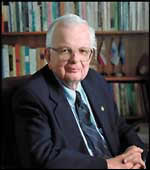Former president of Sac State documents history of CSU

don gerth:Don Gerth:Courtesy Photo
February 17, 2010
When Don Gerth retired as president from Sacramento State, he could have become a trustee professor, and perhaps taught a class or two while collecting two to three years worth of salary.
Instead, Gerth opted to have the California State University pay for the cost of writing a history of the CSU.
“I think it is reflective of his dedication,” said Tim Hodson, executive director of the Center for California Studies at Sac State, whose office cut the checks for Gerth from the chancellor’s office while he wrote the book. “He’s basically spent his whole adult life working for the CSU, and he wanted to make sure there was history of it.”
“The People’s University” captures the CSU from its first campus in San Francisco in 1857 until the present, with 23 campuses, which serve more than 400,000 students.
“There is a quite a history to the California State University system,” Gerth said. “And it’s an exciting history.”
The 694-page book offers many insights and conclusions into the state of the CSU now. It also covers the negotiations of the Master Plan for Higher Education, which Gerth experienced firsthand.
At the behest of Glen Dumpke, a lead negotiator of the Master Plan, Gerth conducted research into the best way to evaluate incoming admissions into the CSU. In this role, Gerth came to know all of the parties involved in the negotiations.
Gerth explains in the book that the birth of the CSU came about when the state Legislature determined the state needed institutions of higher education in the second half of the 1800s, Gerth said.
The legislature undertook the financing of a school that was being built in San Francisco, but a small earthquake that destroyed some of the school, and the fact that some legislators viewed San Francisco to be a “city of sin,” ultimately led to the school moving to San Jose in 1862, the same site where San Jose State is today.
Many citizens’ movements later created other campuses across different regions of California as well.
This distinction of creating colleges to serve certain regions of the state, Gerth said, is the major reason why he considers the CSU system to offer the “people’s” universities.
“It’s a different kind of university,” Gerth said. “Our focus in many ways is on California, and on the regions and people of California.”
Gerth said friends urged him to write the book, and he felt a need to write it because of his commitment as a scholar.
Gerth was president of Sac State for 19 years when he retired in 2003, the longest run for any president in the university’s history. Previously, Gerth served as a professor of political science at San Francisco State, worked in chancellor’s office and served as president of Chico State and CSU Dominguez Hills, a career in the CSU that spans more than four decades.
Nancy Shulock, professor and executive director for the Institute of Higher Learning and Policy at Sac State, said because of his firsthand experience and knowledge of the subject, Gerth was a good candidate for writing the history.
“I don’t think he could have retired until he wrote this book,” Shulock said. “He’s given his life to the California State University.”
Gerth said he most enjoyed his time as a university president.
“It’s wonderful to be on a campus,” Gerth said. “There are students are all over and the faculty are smart people and interesting people.”
Shulock said Gerth came as president with a great philosophy, which recognized Sac State as connected to the region and the capitol.
“People erroneously think of the CSU as a secondary UC,” Shulock said. “Gerth said we are a regional university, and our region happens to be the state capital.”
Under Gerth, the Center for California Studies and the state government fellowship programs were expanded, Shulock said.Hodson said Gerth really believed in the mission of the CSU as regional university.
“He believed we weren’t a stepchild of the UCs,” Hodson said. “That we were different but just as good, but we had particular mandate in producing an educated workforce for the state of California.”
Timothy Sandoval can be reached at [email protected].




























































































































